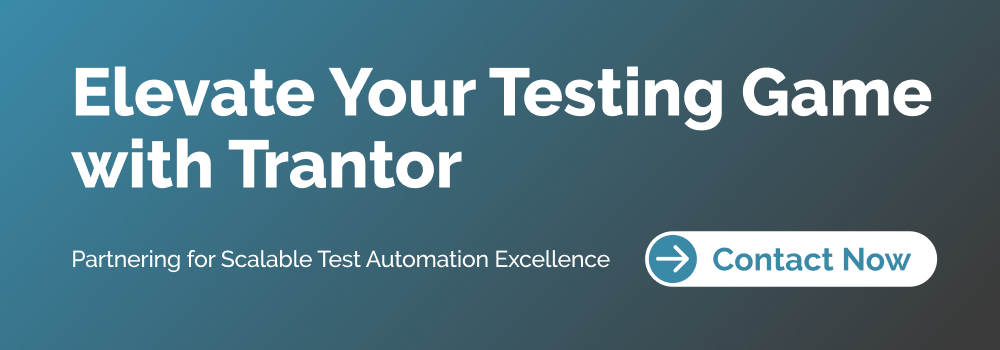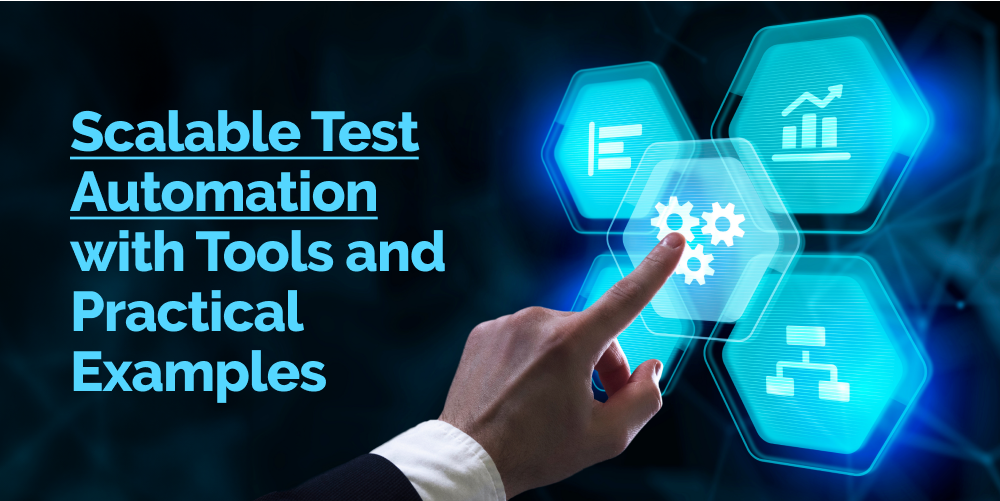Automation, zBlog
A Roadmap to Building a Scalable Test Automation Framework: Tools, Integrations and Real-World Examples
Team Trantor | Updated: January 5, 2024
Introduction
As software delivery accelerates into DevOps and continuous deployment, manually validating intricate code changes and technology integrations becomes humanly unscalable. Industrialized test automation is now a non-negotiable capability for technology teams to maintain velocity without compromising quality.
But building reliable, expansive automated testing pipelines relies first on selecting flexible test automation frameworks that align with your development stack, applications architecture, and primary test use cases. Equally important is figuring integrate disparate testing tools into a consistent system of insight.
This comprehensive roadmap draws on real-world examples to illustrate proven practices around evaluation criteria, highly rated open source test automation frameworks, integration architectures, metrics reporting, and pitfalls to avoid when implementing test automation enterprise solutions.
Part 1 – Analyzing Key Decision Factors Across Test Automation Tools

Gaining cross-functional consensus across development managers, quality engineers, and site reliability professionals is essential for defining cohesive test automation roadmaps that cover:
- Identifying Current Testing Method Gaps
Product technology leaders should guide high-level test automation framework decisions based on release velocity trends, quality benchmarking, and the severity or patterns behind recent production issues. This helps determine where repetitive or inconsistent manual testing efforts are bottlenecking delivery speed the most severely and therefore top automation priorities. - Defining Primary Use Case Requirements
Test automation encompasses a huge variety of potential applications and tools, rather than any single solution. API testing, responsive web and mobile UI validation, security penetration testing, end-user workflow monitoring, load testing, and database integrity checks each necessitate distinct test automation frameworks aligned to those specialized contexts. Attempting an ill-fitted, one-size-fits-all automation approach often leads to over-investment in the wrong areas or critical testing gaps. - Assessing Language and Infrastructure Compatibility Factors
The configurations of backend systems and types of databases leveraged should also influence compatibility with potential test automation frameworks. For example, NodeJS web services have very different tool integration and developer experience considerations compared to Java-based mainframe transactional databases. Ignoring technology constraints or the preferences of engineers supporting affected applications post-deployment leads to long-term maintenance issues.
Top Open Source Test Automation Frameworks by Primary Use Case
Independent industry analysts like Gartner continuously evaluate the spectrum of test automation ecosystems across key segments like API testing, web and mobile UI flows, and unit testing frameworks.
Their latest Magic Quadrant assessments combined with credible surveys of over 60,000 software developers on StackOverflow highlight the highest-rated open-source test automation solutions:
API Testing Frameworks
- Postman
- Karate API
- RestAssured
Web Application UI Testing
- Selenium
- TestCafe
- Cypress
Mobile Testing Frameworks
- Appium
- Espresso
- XCUITest
Unit Testing Frameworks
- JUnit
- NUnit
- PyUnit
Performance & Load Testing
- k6
- Locust
- JMeter
Selenium retains the most dominant mindshare for web UI test automation, while Appium continues leading mobile test use cases. Postman has become the industry standard API testing tool. JUnit, PyUnit, and NUnit remain widely leveraged by developers for unit testing workflows.
Architecting Cohesive Automation Frameworks Combining Multiple Open Source Tools
While distinct test frameworks naturally specialize around specific applications and environments, integrating their outputs into a consistent system of record provides the most flexibility. Architecting reliable pipelines around individual tool strengths while minimizing duplication enables scale.
For example, pairing the highly structured Selenium IDE recorder for web test case generation with the JUnit framework for enhanced reporting and CI/CD integration improves structure. API tests built leveraging Postman’s intuitive builder can feed into the Newman command line interface for scripting and increased automation. Appium’s device automation farms can be combined with open-source automation testing tools like Appetize to validate mobile applications against thousands of real device and OS combinations in the cloud.
This modular combination approach prevents over-reliance on any single vendor while allowing interchangeable open-source elements to plug into a consistent testing harness adaptable to future use cases.
Part 2 – Common Test Automation Pitfalls to Avoid

Despite nearly all enterprises recognizing industrialized test automation is essential for maintaining quality standards at digital delivery speeds, industry surveys reveal over 70% of companies still face issues trying to scale automation efforts across the business.
The most common anti-patterns that erode returns from test automation programs include:
- Lacking Explicit Governance Standards Around Testing Technology Decisions
The absence of centralized governance frequently lets problematic tool sprawl spiral as individual teams independently adopt disparate solutions. This makes managing costs, data integration, and training new engineers on a tangled web of institutional knowledge extremely challenging long term. Either an architecture review board or centralized test platform team needs explicit authority to define standards. - Automating Existing Manual Processes Without Optimization First
Simply replicating inefficient manual test cases with automated scripts provides marginal returns. Teams must first refine those test suites using risk analysis, usage analytics, and test case reduction principles to focus automation on truly business-critical flows. Resources invested into converting irrelevant tests could often generate 10X+ more ROI if allocated towards better manual testing or entirely new types of automated checks. - Prioritizing End-to-End UI Validation Over API and Unit Level Testing
UI testing remains imperative for final stage user acceptance assurance. Lack of investment into API, integration, and unit testing leaves critical business logic flaws invisible until much later in delivery schedules. Technology leaders who ignore fundamental test pyramid principles will continue fighting intermittent, difficult-to-diagnose runtime issues despite extensive UI automation. - Inadequate Investment Into Specialized Skill Building Around Test Infrastructure
Given the increased complexity of navigating and maintaining the many moving parts of testing pipelines, DevOps research shows elite performers hire dedicated software development engineers explicitly focused on test infrastructure. Attempting highly intricate test automation absent seasoned QA engineers with coding abilities and strong operational backgrounds often backfires.
Part 3 – World-Class Framework Reporting and Analytics Capabilities

Beyond the test outputs themselves, central reporting dashboards digest real time automation signals into actionable insights establishing expected baselines and guardrails.
Test Run Reporting Essentials
Robust outputs detail:
- Total test cases executed
- Percentage passed/failed/skipped
- Failure rate trends over time
- Failure density identifying flaky tests
- Code coverage metrics
- Test duration and performance
Manual Testing Enhancements
Analytics further optimize human capital costs by:
- Identifying frequently repeated manual test cases for next-wave automation priorities
- Alerting engineers of real-time production issues connected to recent test failures
Executive Reporting
C-suite aligned reporting communicates:
- Release stability and quality KPIs
- Automation coverage/maturity benchmarks
- Cyber risk levels from security tests
Part 4 – The Road Ahead with Test Automation and Validation Innovation

While market spending on test automation will surpass $70 billion by 2027, the road ahead will challenge traditional testing assumptions.
As event stream processing, Internet of Things sensors and machine learning permeate into backend systems, reactive programming changes requirements. Smart test pipelines must validate randomized, disproportionate responses across architectures constantly learning and evolving.
Maintaining quality assurance then requires balancing sophisticated automation frameworks with discretionary human oversight through observability tooling. Risk-based prioritization will grow more vital with unlimited test cases possible.
In conclusion, today’s test automation castle built on the principles above must also prepare to flex, adapt, and transform against turbulent industry changes ahead. By taking an outside-in view and aligning present internal maturity with future delivery models, technology executives can craft an incrementally powerful automated testing strategy that sustains measurable returns for years ahead.
Trantor, a pioneering force in technology solutions, stands ready to elevate your test automation journey. With a focus on innovation and a commitment to excellence, Trantor empowers technology teams to navigate the complexities of test automation seamlessly. By leveraging our expertise, organizations can transform their testing processes, ensuring accelerated delivery without compromising on quality.
Revolutionize your test automation strategy with Trantor, a trusted leader in technology solutions. Our expertise, coupled with a customer-centric approach, enables organizations to build scalable frameworks aligned with their unique needs. Take the next step in your testing journey—connect with Trantor experts for innovative solutions that propel your business forward.





